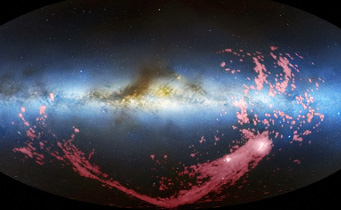Astronomers have discovered hot, young stars in the Leading Arm of the Magellanic Stream, calling the history of the Magellanic Clouds once again into question.

NRAO / AUI / NSF
The Magellanic Stream — a long ribbon of gas stretching nearly half way around the Milky Way and trailing our galaxy’s two small companions, the Magellanic Clouds — has a fascinating history. Most of the stream was stripped from the Small Magellanic Cloud some 2 billion years ago, but a small pocket of it was formed more recently from the Large Magellanic Cloud.
Since the stream’s discovery in the early 1970s, astronomers have eagerly studied this gaseous filament because it offers the chance to directly probe the nearby result of a powerful tidal interaction. For decades astronomers thought the Magellanic Clouds were old acquaintances with our galaxy, having orbited the Milky Way multiple times over the past several billion years.
Then in 2002 and 2005, astronomers using the Hubble Space Telescope discovered the clouds were moving much faster than anyone had expected. Such rapid movement would make it extremely hard for the clouds to be bound to the Milky Way. Later computer modeling by Gurtina Besla (Columbia University) and colleagues concluded that the clouds have probably never completed an orbit around the Milky Way.
But now an international team of astronomers led by Dana Casetti-Dinescu (Southern Connecticut State University) has for the first time detected young stars in the stream’s Leading Arm — a wide and irregular feature at the front end — suggesting once again the stream is an old acquaintance of the Milky Way.
Star formation is a natural consequence of a tidal interaction. As the Leading Arm travels through the Milky Way’s halo, the arm’s gas feels a headwind, much as a runner feels a wind even on the stillest day, and becomes compressed enough to spark star formation. Note this interaction has to be relatively weak: if the collision is too violent, instead the gas is stripped away and no stars form.
The team observed 42 candidate stars using the 6.5-m Baade Telescope in Chile and verified that 19 are young, massive stars in the Leading Arm. But did they form within the stream itself, or are they runaway stars kicked out of a neighboring galaxy by some dynamic push (say, a supernova’s blast or via close passes within a star cluster)?
While it’s difficult to rule out these newly identified stars as runaways on a case-by-case basis, the fact that five of them have similar radial velocities argues strongly that they were formed together. It’s very unlikely that they were all ejected in the same direction. Additionally, one massive star among the 19 is so young — just 1 or 2 million years old — that it could not have reached its current location from either the Milky Way’s disk or from one of the Magellanic Clouds, says coauthor Terrance Girard (Yale University).
Finding embedded stars allows astronomers to determine accurate distances to the Leading Arm. Indeed, these observations show that it’s extremely close to the Milky Way’s disk — 40,000 light-years closer than current models predict possible.
The presence of hot, young stars so close to the Milky Way suggest the more distant clouds are moving sluggishly. It’s simply easier to pull star-forming gas closer if the clouds are moving slower. However, this contradicts previous HST measurements and current models, leading the team to question if the clouds are truly on their first visit, just now “falling in” from elsewhere within the Local Group, or instead have been circling the Milky Way for a long time.
Not all astronomers, however, agree that the infall scenario should be questioned. The stars pose a challenge to “all orbital models of the Magellanic System, not just the first infall scenario,” says Besla, who was excited to hear about their discovery.
Casetti-Dinescu stresses that careful modeling is needed to firm up details about the Magellanic Stream’s complex history and future. While there is little doubt the clouds will eventually be captured and incorporated into the Milky Way, we’re unsure of the timescale at which this will happen.
We also need to find more young stars. “What we have discovered is probably the ‘tip of the iceberg’ ” writes Casetti-Dinescu.
Reference:
D. I. Casetti-Dinescu, et al. “Recent Star Formation in the Leading Arm of the Magellanic Stream” submitted to Astrophysical Journal Letters
 0
0
Comments
You must be logged in to post a comment.